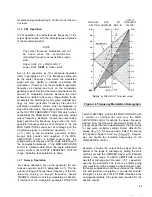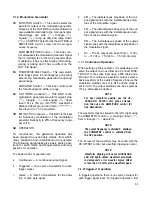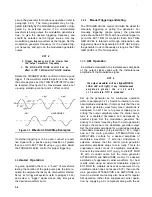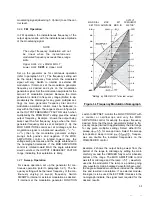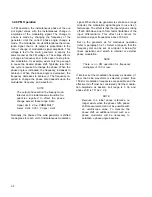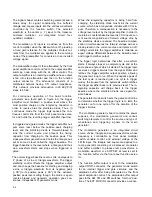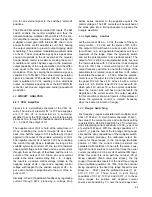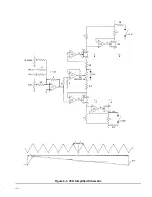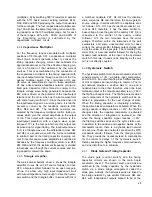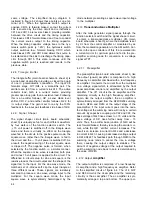
center by an amount determined by the modulation
amplitude.
-Phase Modulation (PM): As in External Modulation.
A m p l i t u d e o f m o d u l a t o r
,
,
f u n c t i o n s
varies phase up to
External Modulation
A BNC feeds an external signal to the modulating cir-
cuits when selected by a front panel modulation tog-
gle switch in the EXT position.
Amplitude Modulation (AM):
External modulating
signals with zero dc component produce suppressed
carrier modulation; i.e., a carrier (at main generator
function output) amplitude of zero. The function out-
put modulated signal has an amplitude sensitivity of
3 volts peak (1.5 Vp into
per volt peak in. A car-
rier signal level at the function output can be pro-
duced at a sensitivity of 3 Vp (I .5 Vp into 500) per 1 Vp
dc component in. Modulating the dc component mod-
ulates the carrier level. Percent modulation (AM) will
be the ratio of the peak ac to peak dc of the modulating
signal. Input impedance is >2.5
Frequency Modulation (FM) and Sweep: Sensitivity is
20% of frequency range/volt peak. Linear behavior
results only when all instantaneous frequencies call-
ed for fall within the frequency range (2
x
multiplier
to 0.002
x
multiplier). The instantaneous frequency
called for is the multiplier and dial setting altered by
the instantaneous voltage at the modulation input. In-
put impedance is 5
Phase Modulation (PM): Sensitivity is
phase shift/
volt peak. Linear behavior results only when all instan-
taneous transition frequencies called for fall within
the frequency range (2
x
multiplier to 0.002
x
multi-
plier).The instantaneous frequencies called for will
depend heavily on the modulation frequency. and
waveform. Inoperative at frequency multiplier settings
below 100. Input frequencies roll off at 6 dB/octave
above one half of full range frequency and above
150 kHz. Input impedance is IO
1.2.1.4,
Frequency Range
0.0002
Hz to 20 MHz in
IO
overlapping ranges with
approximately
1 %
vernier control.
1.2.1.5
Function Output
,
and
selectableandvariable to 30V p-p
(15V p-p into
and
up to 15 Vp (7.5 Vp
into
All waveforms and dc can supply 150 mA
1-2
peak current and may be attenuated to 60 dB in 20
dB
steps. An additional 20 dB vernier also controls the
w a v e f o r m a m p l i t u d e s .
1.2.1.6
Adjustable Waveform Start/Stop Point
Approximately -
to +
to 2 MHz (operative on
sine and triangle waveforms only).
1.2.1.7
DC Output and DC Offset
Selectable through function output
Controlled
b y f r o n t p a n e l c o n t r o l s t o a m i n i m u m o f
14.4 Vdc( 7.2 Vdc into
with signal peak plus
offset limited to
15 Vdc (
7.5 Vdc into
DC off-
set and wave form attenuated proportionately by the
60 dB output attenuator.
1.2.1.8
External Modulation Input
AM: Sensitivity of 3 Vp out/Vp (1.5V into 503). Input
impedance is >2.5
FM: Sensitivity of 20% of frequency range/Vp. Input
impedance is 5
PM :
Sensitivity of
phase shift/VP. Input im-
pedance is 1O
1.2.1.9
Symmetry
Symmetry of all waveform outputs is continuously ad-
justable from 1 :1 9 to 19:1. Varying symmetry provides
variable duty-cycle pulses, sawtooth ramps and non-
symmetrical sine waves.
N O T E
W h e n S Y M M E T R Y c o n t r o l i s u s e d , i n -
dicated frequency is divided by approx-
ima tely IO.
1.2.1.10 Sync Output (TTL)
TTL level pulse which will drive 10 TTL loads. Fre-
quency and time symmetry are the same as for func-
tion output.
1.2.1.11 Trlgger and Gate
Input Range: IV p-p to
IOV.
Input Impedance: IO
33 pF.
Pulse Width: 25 ns minimum.
Repetition Rate: IO MHz maximum.
Adjustable triggered signal start/stop point: approxi-
mately -
to
to 2 MHz.








